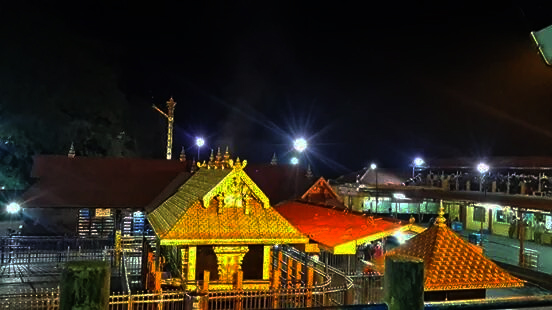Sabarimala is a Hindu pilgrimage centre located at the Periyar Tiger Reserve in theWestern Ghat mountain ranges ofPathanamthitta District, Perunad grama panchayat in Kerala. It is one of the largest annual pilgrimages in the world with an estimated 45–50 million devotees visiting every year.[1][2] Ayyappan's temple is situated amidst 18 hills. The temple is situated on a hilltop at an altitude of 1260 m (4,133 ft) above mean sea level, and is surrounded by mountains and dense forests. The dense forest, (Periyar Tiger Reserve), around the temple is known as Poongavanam. Temples exist in each of the hills surrounding Sabarimala. While functional and intact temples exist at many places in the surrounding areas like Nilakkal, Kalaketty, and Karimala remnants of old temples survive to this day on remaining hills. 
The shrine at Sabarimala is an ancient temple of
Ayyappan also known as
sasta and
Dharmasasta. In the 12th century, Manikandan, a prince of Pandalam dynasty, meditated at Sabarimala temple and became one with the divine. Manikandan was an avatar of Ayyappan.
Sabarimala is linked to
pilgrimage predominantly undertaken by Hindus. Sabarimala pilgrims can be identified easily, as they wear black or blue dress. They do not shave until the completion of the pilgrimage, and smear
Vibhuti or
sandal paste on their forehead.
In 1991, the Kerala High Court restricted entry of women above the age of 10 and below the age of 50 from Sabarimala Shrine as they were of the menstruating age.
On 28th September 2018, the Supreme Court of India, lifted the ban on the entry of women. It said that, discrimination against women on any grounds, even religious is unconstitutional.
[3][4]

Comments
Post a Comment